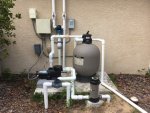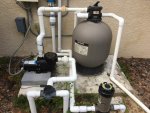Not everybody can drain to the street or sewer. My city doesn't allow it, but OKs dumping it in an open field where it can soak in (and trap the salt in the dirt, I presume). I have a place to dump mine, but I'll bet 90% of the pools here in town dump in the street anyway. I think it's mainly the salt they're worried about. The chlorine can be eliminated before a purge. I guess they don't worry about what else is lurking around in 5 year old pool water!
When they flush the hydrants around here, they pump the water through a filter, then it flows into the gutters. So there is probably something that will trap all of (most of?) the nasties of pool water, but I'm not sure what it is or where to get one... Google time?
Oh, and there's those services that'll clean your pool water of everything, in place, so you don't even need to dump any. But that won't really address why you're emptying your pool...
Off the top of my head, I'd guess that you could effect some or all of the tile repair without draining your pool. Maybe just the top bit to access the tile. You'd have to work carefully, but it could be done. I'd also guess that you'll want something flexible between the tile and coping, but maybe not caulk. The tile and coping are expanding and contracting at different rates, which is what caused that grout to fail. Call
these guys, they'll have the right stuff. It sounds like your plaster is nearing end of life, and I don't think it can be effectively repaired, with or without water in your pool. Anything you might pull off would be stop-gap, and probably a losing battle as the rest of it starts to come apart. Is there a way to calculate how much time you have left? Not sure, probably not. TFPC will prolong the inevitable a bit. I think it basically comes down to what you want to live with. As long as the plaster is still water tight and not leaking into the gunite, it's about aesthetics and what you can live with. You can test a pool to see if it's leaking. If not, take some pictures, TFPC religiously, leave it alone for a year, then compare the pic's with how it's actually degrading. Then decide for yourself how long you have left until you can't stand looking at the plaster any longer...
But here's something important to consider. All plaster, to some degree, but more so with older plaster, is subject to blistering when you remove all the water. Especially if you do so for any length of time (like while you're doing repairs elsewhere). Once you remove the weight of the water off the plaster, and we're talking a LOT of weight, you effectively remove what is holding some of your failing plaster in place. A typical result of this phenomenon is plaster bubbles. They'll appear like little bumps, and they'll eventually pop and expose the plaster aggregate. They'll be rough patches, and unsightly as they contrast against the remaining plaster. Oh, and the blistering can continue well after you restore the water, so there's that. (I saw this for myself in my pool, and my water was out of the pool for less than 24 hours.) I'd think twice about emptying your pool before you're ready to replace the plaster. You could easily make it worse.
Like me, you probably bought a pool that was not taken care of as well as it could have been, and you've got a plaster re-do in your future. There's no magic bullet. (I just redid mine after living in the house for 3 years. The plaster was only six years old and an acid wash finished the job and destroyed it.) Look at the bright side, you'll get to pick out a new finish, and maybe new tile, and your pool will look like new!
OH, sorry, the SWG. If you think you're going to replaster soon, like now, then wait. If you're going to stick it out a year or more, put in the SWG. You're only talking the cost of the salt (what, about $75). And you're going to have to solve the dumping issue eventually, that's inevitable at some point, even after you replaster. So enjoy the SWG this summer and figure out the dumping issue when you need to. Heck, pump it across the dirt road, help keep it weed free! (Or look into that filter gizmo.)
 I’ve only had an AG pool before and had the AqualTrol there—installation was pretty simple for my hubby on that but this is a whole new beast. I’m attaching pictures of the equipment pad. Would it be a plumbing nightmare? The pool was built in 2005 but the solar panels were added later.
I’ve only had an AG pool before and had the AqualTrol there—installation was pretty simple for my hubby on that but this is a whole new beast. I’m attaching pictures of the equipment pad. Would it be a plumbing nightmare? The pool was built in 2005 but the solar panels were added later.


